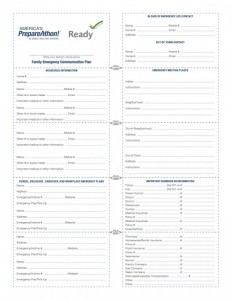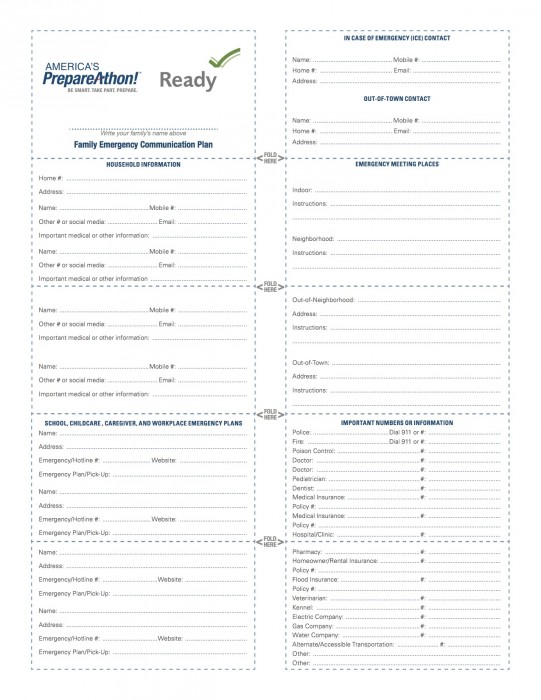Disaster can strike quickly and without warning. It can force you to evacuate your neighborhood or confine you to your home. What would you do if basic services– water, gas, electricity or telephones– were cut off? Local officials and relief workers will be on the scene after a disaster, but they cannot reach everyone right away.
Take these four basic steps to preparedness
1. Find out what could happen to you
The American Red Cross is a great tool for disaster planning. Contact your local chapter and be ready to take notes. Ask what types of disasters are most likely to happen in your area and request information on how to prepare for each. Learn about your community’s warning signals: what they sound like and what you should do when you hear them. Ask about animal care after a disaster; animals are not allowed inside emergency shelters because of health regulations. Find out how to help elderly or disabled persons, if needed. Find out about the disaster plans at your workplace, your children’s school or day care center, and other places where your family spends time.
2. Create a disaster plan
Meet with your family and discuss why you need to prepare for disaster. Explain the dangers of terrorism, fire, severe weather and earthquakes to children. Plan to share responsibilities and work together as a team. Discuss the types of disasters that are most likely to happen. Explain what to do in each case.
Pick two places to meet.
One should be right outside your home in case of a sudden emergency, like a fire. The other should be outside your neighborhood in case you can’t return home. Everyone must know the address and phone number of this outside location. Ask an out-of-state friend who should still have their basic services to be your “family contact.” Other family members should call this person and tell them where they are. Everyone must know your contact’s phone number.
If you like to have things written down, go to ready.gov and get their ready-made disaster plan templates. Including this wallet-sized version. 
3. Complete this checklist
Conduct a home hazard hunt. In a disaster, ordinary items in the home can cause injury and damage. Anything that can move, fall, break or cause a fire is a potential hazard.
Repair defective electrical wiring and leaky gas connections.
Fasten shelves securely.
Place large, heavy objects on lower shelves.
Hang pictures and mirrors away from beds.
Brace overhead light fixtures.
Secure water heater. Strap to wall studs.
Repair cracks in ceilings or foundations.
Store weed killers, pesticides and flammable products away from heat sources.
Place oily waste in covered metal cans.
Clean and repair chimneys, flue pipes, vent connectors and gas vents.
Post emergency telephone numbers by phones.
Teach children how and when to call 9-1-1 or your local Emergency Medical Services number for emergency help.
Show each family member how and when to turn off the utilities (water, gas and electricity) at the main switches.
Check if you have adequate insurance coverage.
Get training from the fire department for each family member on how to use the fire extinguisher (ABC type), and show them where it’s kept.
Install smoke detectors on each level of your home, especially near bedrooms.
Stock emergency supplies and assemble a Disaster Supplies Kit. Think through everything you’ll need in an emergency and be sure to include water, food, sanitation supplies, flashlights and important documents.
Take a Red Cross first aid and CPR class.
Determine the best escape routes from your home. Find two ways out of each room.
Find the safe places in your home for each type of disaster.
4. Practice and maintain your plan
Be sure to quiz your kids every six months or so and conduct fire and emergency evacuations. Also, replace stored water and stored food every six months and test and recharge your fire extinguisher according to manufacturer’s instructions. Test your smoke detectors monthly and change the batteries at least once a year.
Meet with your neighbors to plan how the neighborhood could work together after a disaster until help arrives. If you’re a member of a neighborhood organization, such as a home association or crime watch group, introduce disaster preparedness as a new activity. Know your neighbors’ special skills (e.g., medical, technical) and consider how you could help neighbors who have special needs, such as disabled and elderly persons. Make plans for child care in case parents can’t get home. Consider an alternative power source, like a generator.
If disaster strikes, calmly put your plan into action.
First, check for injuries and be ready to give first aid and get help for seriously injured people. Then, listen to your battery-powered radio for news and instructions. Finally, assess your environment. Check for damage in your home using flashlights. Do not light matches or turn on electrical switches, if you suspect damage. Sniff for gas leaks, starting at the water heater. If you smell gas or suspect a leak, turn off the main gas valve, open windows and get everyone outside quickly. Shut off any other damaged utilities. (You will need a professional to turn gas back on.) Clean up spilled medicines, bleaches, gasoline and other flammable liquids immediately.
In addition:
Confine or secure your pets.
Call your family contact to warn them you have instigated your emergency plan.
Check on your neighbors, especially elderly or disabled persons.
Make sure you have an adequate water supply in case service is cut off.
Stay away from downed power lines.

